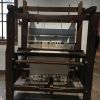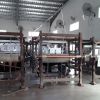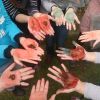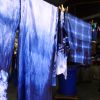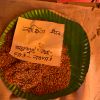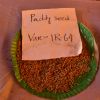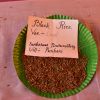The search found 278 results in 0.017 seconds.
Search results
Rembrandt Bridge (Rembrandtbrug) was built in 1983 as a replica of a 17th-century bridge that was in the same place. The bridge was rebuilt in color white. However, according to archive research from Heritage and Environment of Leiden (Erfgoed Leiden en Omstreken), the original bridge design in 1768 was in English red with black. The research did not please some of the local residents. Friends of Rembrandt Bridge (Vrienden van de Rembrandtbrug) made petitions against the change of color and stuck the "Liever wit dan dit (Better white that this)" over the trial color.
First church visited in Leiden: Marekerk. Architecture may be reminiscent of a Catholic church, but our guide told us that it is a Protestant church. The building is majestic, a round dome overlooking it, and it is still used by the Protestant community of Leiden. The past and current relations between Catholics and Protestants in Leiden are relatively complicated, and certainly competitive, as everywhere else. We did not expect it. Nor did we expect so many churches and stories in this city.
The Netherlands was placed under German occupation during the second World War after the country was invaded by the Nazi Germany on the 10th of May, 1940, which continued till the German Surrender in 1945. Nearly seventy percent of the country's Jewish population was killed in Nazi concentration camps during these years.
The 1890 photograph of ‘laundry day’ shows people washing, bleaching and drying their clothes on the side of the canals of Leiden. According to our sources, the people in Leiden used the water that was centrally heated by the factories, once a week, to wash their clothes once a week. They needed the entire streets for the laundry process and used it as a community.
“Laken” means woollen fabric or cloth. Weaving became the main economy for Leiden in the 17th century and the city became the working center. The city was populated due to the availability of works in the weaving industry. During the Dutch Golden Age, Leiden cloth was imported via Amsterdam, made quality cloth, national uniforms and the process was carried out by people of all ages of the city, from as young as 4 years old to and old person. To secure the quality of products which was the prestige of the city, they built the Lakenhal in 1641.
The setting of the Saturday Market is a completely different image from the other local shops during the weekdays. It opens twice a week - a small one on Wednesdays, and the main one on Saturdays from 8:00 am to 5:00 pm. It is full of products from local and as well as non-Ducth origin (e.g Mabroek). The uniqueness of the market makes people visit it and makes the experience worthwhile. People come not only to shop but also to relax, to enjoy their Saturdays with family and friends.
The keys are a symbol of Leiden and are found everywhere. As a first time visitor I found them odd. As we talked to different people we were told that these are the keys of Saint Peter. Like the coats of arms in Ghana that talks about the belief of the people and acts as a cultural symbol, the keys of Saint Peter have become a symbol that people identify themselves with.
The Stadhuis Town Hall, in Leiden, was built in the 1600 in what is called the Renaissance style of architecture. Made of German sandstone, it is also the longest Town Hall building in the Netherlands. One February morning in 1929, a fire broke out in the Town Hall burning it to the ground as it was so cold that part of the water being used to extinguish the fire froze as soon as it hit the façade. It was then re-built in the old style using what material remained.
There are many old buildings and records in Leiden. Weaving was the main economy in the 17th century and the city was known for its quality. But now there are only about 15 weavers. They weave using eight looms. Weavers, though few in numbers, keep the practice alive through different ways – efforts of the volunteers, group meeting, preservation of buildings like Weaver’s House, Museum De Lakenhal, publication in weaving magazines etc.
While visiting the craft beer brewery, Benjamin, one of the co-founders of the brewery, was the tour guide for our visit. I find three terms were used frequently in his talk: 'to be honest,' 'but' and 'the beauty is.' The image been built from these word choices breaks some stereotypes on craft in my mind, but also proves some imaginations I had.
“ Pronck” is one of the brewing company in Leiden, Netherlands, which was founded in 2014. Today we have Benjamin, one of the founder, who was a tax lawyer before guided us. His love and enthusiasm toward beer inspired him to start the brewery without the background of brewing ancestors, but with his university friends.
For seven centuries, the identity of the city of Leiden was determined by woollen cloth fabric. The last cloth manufacturer closed in 1977, and with it the long tradition of woollen cloth ended.
As for the semester of Spring 2019, some changes were made such as the adoption of theme-based group discussion. The students were divided into four discussion groups on (1) language and memory, (2) landscape and place, (3) gender and labour, and (4) market and aesthetics. These four sub-themes were adopted in the HaB methodologies workshop in in October 2018. This new trial helped to open up viewpoints based on cultural and historical understandings acquired in the previous stage.
Starting 2012, the TNUA Centre for Traditional Arts (CTA) initiated a series of field courses, including indigenous boat making, bark cloth making, banana fiber crafts, ritual parades etc.; the course of ‘Natural Dyeing’ was one of them. These courses aimed to bring students out of the classroom to learn from the soil and different people who give life to traditional arts, and to learn how traditional arts are related to the society and their generation. The 2013 course of ‘Natural Dyeing’, conducted with many partners, was divided into three main stages.
Similar in many other places in the world, natural dyeing in Taiwan disappeared when the synthetic dye was widely distributed. Taiwan underwent fast modernization during the Japanese colonial period (1895-1945) that was also when Taiwanese indigo dye production and dyeing went down the lane. As a massive amount of Japanese machine-printed textiles entered the Taiwanese market, local dyeing workshops quickly shut down or turned into dealer shops of ready-made textiles. Since then, Taiwan indigo industry, once prevailing, now only existed in the memory of the elders.
Walking the Naga Day on 10 January is where memory and meaning meet for the contemporary Naga . It is also the first time that conscientious Nagas decided to create this event in a public forum to awaken every Naga's idea of home and the community.
It brings together the voices, visions and many aspirations of the community as they straddle the borders of peace and conflict , of work and ethics, of construction and destruction, of harmony and violence as they go forth with the promise of a new year into a more stable future .
One of the items on display at most of the local Autonomous Council sponsored/organized exhibitions at BTC areas of Assam is different varieties of rice seeds, including indigous and hybrid ones. The main target is to create awareness of hybrid varieties of rice but what it does is also make aundience realize the invisibility of indigenous varieties.
In the first figure, the governors of Myanmar are being awarded the cloth as a mark of honour. Luntaya acheik was the sacred cloth of the ancient Myanmar royals. But under the colonial rule everyone could wear this acheik.
To know the preferences of the people of Myanmar better, the governemnt conducted a survey after which the acheik became the national costume.
The family is a social institution. It is beautiful to see a mother and her children together because it reflects the natural love and the affectability that exists between her and her offsprings. In Leiden, the parental concept is very visible in the streets because it is found that the parents and their children are at the edge of a bicycle (the parents and their children: case where all drive together; the case where the mother also pilot alone). Education is one of the priorities of the population of this city of the Netherlands.
The Saturday Market opens every Saturday along the canals (Nieuwe Rijn, Vismarkt en Botermarkt) and a smaller one on Wednesdays. There are many makeshift stalls on Saturdays but fewer on Wednesdays. The stalls sell - flowers, bags, toys, foods/ drinks , accessories (bicycle, tailor, fashion etc), speciality food like Middle East cuisine/ ingredients, Dutch herring, chesses etc. The stalls are always busy.
Pages















